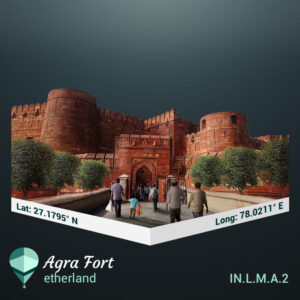 Agra fort, also known as the Red Fort, is a historical fort of the 16th century built in red sandstone. Agra fort is located in the Agra city of north-central India and in 1983 it was made a UNESCO World Heritage Site along many other Agra monuments. The fortress was ordered by Akbar I and was until 1638 the main residence of the Mughal's Dynasty Emperors.
Agra fort, also known as the Red Fort, is a historical fort of the 16th century built in red sandstone. Agra fort is located in the Agra city of north-central India and in 1983 it was made a UNESCO World Heritage Site along many other Agra monuments. The fortress was ordered by Akbar I and was until 1638 the main residence of the Mughal's Dynasty Emperors.
Some 2.5 km Northwest of the iconic monument of India, the Taj Mahal, in the historic walled city of Agra is the Agra Fort. The city of Agra served as the capital of the Mughal Dynasty between 1556 to 1638, when the capital was shifted to Delhi. Agra Fort was commissioned by Akbar, in the way that it stands today, in 1565. It is the 16th-century red stone fort located by the Yamuna River in Uttar Pradesh, India, which was completed in eight years.
As long as Agra stayed the capital of the Mughal Dynasty, Agra Fort served as a royal residence and a military base. Within the red fort, there is Jahangir Palace, Khas Mahal, Sheesh Mahal, Macchi Bhavan, and Shah Jahani Mahal, built by Shah Jahan. In addition to that, there is also an audience hall named as Diwan-i-Khas, Zenana Mina Bazar (female market), and two beautiful mosques, namely Nagina Masjid and Mina Masjid. It is recorded in history that there were more than 500 monuments constructed in the Bengali and Gujarati styles by King Akbar, but it was later destroyed by Shah Jahan to build palaces or destroyed by British colonizers. The total number of monuments is down to two dozen now.
Agra Fort was a brick fort known as ‘Badalgarh’ in a ruined condition when Akbar realized the importance of its location and ordered it rebuilt it for security reasons. It was built during an era of invasions and fortifications. Palaces and forts were built as a symbol of power and to deter opponents. Some 4,000 workers were involved in the construction of the majestic fort. To this day, the fort reminds the tourist of the valor, courage, and royalty of the people who built, captured, and lived in the fort.
The fort is constructed on a semi-circular plan, surrounded by 70 m high and 2.5 km long enclosed walls. There are four gates on its four sides, among which one of the gates is called the Delhi gate. The gate that opens on the riverside is called “Khizri-gate,” which translates as the watergate; other ghats are also constructed. Tourists are allowed to enter from the Amar Singh gate only, and the visit to the fort is also restricted as some portion of the fort is also used by the Indian Army, where tourist entrance is prohibited.
The Agra fort is stretched over an area of 94 acres. So even if the tour of tourists is prohibited and limited, there are a lot of palaces in the fort to see and enjoy. These palaces in the fort have intricate carvings in pure marble and red stones. In addition to these beautiful engravings, the balconies and pavilions in the fort provide beautiful views of the Yamuna River and Taj Mahal that mesmerize and attract tourists in huge numbers. In the fort, there is a wooden drawbridge that was used to cross the moat and reach the mainland. Another famous gateway is the Hathi Pol (Elephant Gate), which is guarded by two life-sized stoned elephants.
The other name for Agra Fort is Qila-i-Akbari (Fort of Akbar). It is wrongly assumed that Red Fort and Agra Fort are the names of the same fort. Red Fort (Laal Qila) is a fort in Delhi built during the Mughal Dynasty.
The fort has survived and saved the insiders from the onslaught of time and nature. For its historical standing, the Agra Fort was added to the list of UNESCO World Heritage Sites. This adds an added attraction for tourists to visit the Agra Fort and attracts thousands of visitors from all over the world.